6 most popular baby sleep-training methods explained
By Claire Gagne
Updated Mar 17, 2023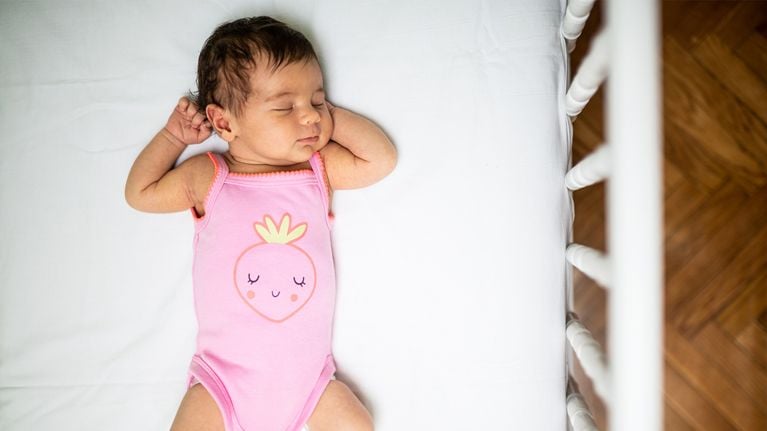
Photo: iStock/SanyaSM
For the first few months of his life, Laura Welk’s baby, Greyson, was a dream sleeper. He had regular naps during the day, and all it took was a calming bottle in the evenings and he would be fast asleep. He would wake up only once a night for a feed, and that would last him until morning.
But when he was about three-and-a-half months old, the routine fell apart. “I would feed him, but he wouldn’t be asleep at the end of the feed,” recalls Welk. “I would rock him until he fell asleep and put him down, and then he would wake up 30 minutes later and I would do it all over again.” Desperate for some rest, Welk brought Greyson into bed with her, but then she ended up just lying still, holding a pacifier in his mouth all night long. “I didn’t know anything about sleep,” says Welk. “I didn’t know you couldn’t just rock them to sleep and then put them down.”
Speaking to a professional
When Greyson was four months old, the first-time parents contacted a sleep consultant, who clued them into a few things that were getting in the way of Greyson sleeping well: All the rocking and pacifying were now ingrained in him as sleep associations—or crutches he needed to fall asleep and stay asleep. They decided to sleep-train him.
Sleep training is a loaded phrase, and one that is often used synonymously with letting your baby self-soothe, or “cry it out,” but that’s not the whole picture, says Alanna McGinn, a certified sleep consultant and the founder of Good Night Sleep Site. “It’s more about being able to teach your baby that they are capable of falling asleep independently,” she says. You want your baby to be able to nod off on their own—ideally without nursing, rocking or using a pacifier—because whatever tools they use to fall asleep at bedtime are the same things they’re going to wake up looking for during the night. Yes, this can feel unloving and even downright cruel. You’ll find experts on both sides of the issue: Breastfeeding advocates say it’s normal for babies of all ages to wake up multiple times to nurse, and even the sleep coaches interviewed for this article disagree with how much crying and distress are acceptable.

Sleep training research
Recent research has shown that, at least in babies older than six months, sleep training with controlled crying and bedtime fading (both described below) improved babies’ sleep and didn’t lead to increased levels of cortisol. This provides some reassurance that a little bit of crying—if it leads to better sleep—likely won’t do your baby any harm.
Paediatrician Michael Dickinson, president of the Canadian Paediatric Society, advises parents to trust their instincts. “I don’t think there’s any evidence to suggest that it’s psychologically damaging to let your baby cry, but I think people need to be reasonable,” he says. “For most of us, letting your baby cry is five to 10 minutes.”
There’s also no need to institute a regimented cry-it-out plan if what you’re currently doing is working for your family. But good sleep habits never hurt, and being able to fall asleep on one's own is a necessary life skill. If you sleep-train at a time that’s developmentally appropriate for your baby and with the basic ingredients of healthy sleep in place, you can minimize the amount of crying your baby (and, let’s face it, you) will do.

What’s the right age for sleep training?
Most sleep coaches say the ideal time to start sleep training (or promote independent sleep, not necessarily using the cry-it-out method) is based on your baby’s development, but is usually somewhere between four and six months, when your baby hasn’t had much time to get used to nursing or rocking to sleep. At this stage, most babies are also developmentally ready to learn the skill of falling asleep on their own, explains Jennifer Garden, an occupational therapist who runs Sleepdreams in Vancouver. Around four months of age, some babies go through a sleep regression because their sleep cycles change and there are longer periods of lighter sleep per cycle. “It’s a great time to work on independent sleep skills,” says McGinn. Other babies’ slumber derails around this time because they are working on new skills, like moving around and rolling. Some parents choose to wait until things settle down before embarking on a sleep-training method, but you don’t have to, says McGinn.
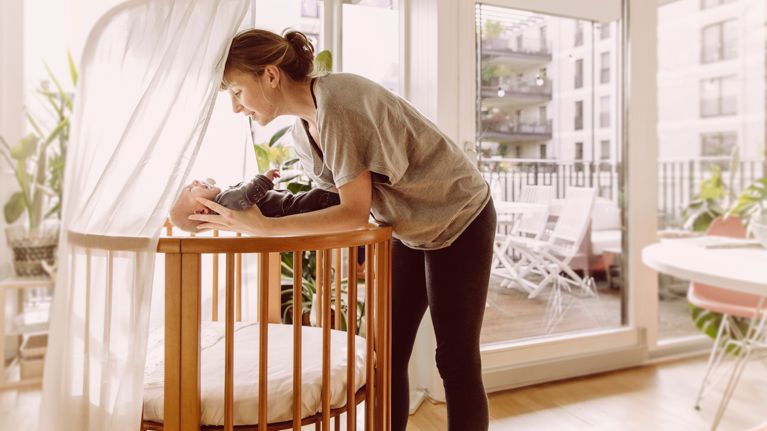
Have an older baby? No worries.
If your baby is older than six months, don’t worry, McGinn says: “It’s never too late to develop good sleep habits.” Dickinson says he finds nine months to be a bit of a sweet spot for parents in terms of getting babies to sleep through the night. “They are at a good age for understanding routines and don’t need to eat during the night,” he explains.
The age of your baby might determine what kind of sleep-training method you choose, though. You could try a gentle shush-pat technique with a five-month-old, but you’ll likely have to leave a one-year-old in the crib as they protest (cry or scream) about the new bedtime arrangement. Don’t attempt a formal sleep-training method before four months, until your baby is able to go longer in between feeds and their circadian rhythm starts to develop. (Many babies this age still feed in the night—contrary to popular thinking, sleep training isn’t synonymous with night weaning.) Dickinson says that many four-month-old babies are biologically able to go through the night without a feed, but that doesn’t mean you shouldn’t respond and feed them if other methods of calming them aren’t working. Since every situation is different, we recommend checking with your doctor before withholding your baby’s night-time feeds.

Before getting started
Before you even think about “training” your baby to fall asleep on their own, make sure you’re following a regular schedule and putting them to bed at a consistent time each night (hint: early is usually better, typically around 7 or 8 p.m.). Starting at about two months old, it’s a good idea to try to put them down drowsy but awake whenever you can, just to get them (and you) used to it, even if they fuss a bit. Make sure that they’ve been awake for an appropriate amount of time before bed (an over- or under-tired baby will have trouble falling asleep), and establish a calming and consistent bedtime routine, like a feed, bath or massage followed by pyjamas and stories or songs. Some experts recommend feeding at the beginning of the routine to avoid having the baby associate the feeding with falling asleep. Ideally, your baby won’t have started to nod off at any point during your bedtime routine. “You really want to make sure your baby is primed for sleep,” says Pamela Mitelman, a psychologist in Montreal who specializes in infant and child sleep. Be conscious, too, of filling their daytime awake periods with enough activity and stimulation, says Garden. “Kids need to be moving in all sorts of ways when they are awake, not just sitting in a bouncy chair,” she says.
Once you’ve got all the ingredients of a good night’s sleep in place and you’re ready to let your baby learn how to fall asleep on their own, here are six common methods to consider.

Check and console
(also known as the Ferber method, graduated extinction, progressive waiting or the interval method)
There are many variations on the check-and-console method, but the general principles are the same: You want to continue to check on your baby at preset intervals but never feed or rock them to sleep, as that would mean they aren’t falling asleep on their own.
After going through your bedtime routine, put your baby in their crib, leave the room and wait a specific amount of time (say, a minute). Then go in and reassure your baby with words like “Mommy loves you” or some kind of touch, such as a rub or pat. McGinn says it’s preferable not to pick the baby up. Garden, on the other hand, reserves this method for babies seven months and older. (In her opinion, younger babies require a parental presence so they know they haven’t been abandoned, especially if they’ve worked themselves up into a frenzy.)
Continue to leave and then check on them, increasing the amount of time between visits until you’ve reached about 10 or 15 minutes, and then just keep at it until they fall asleep. When they wake up, you start the check-and-console intervals all over again.
This technique could take up to a week to work, but you should start seeing some progress after a few nights. Many experts recommend keeping a sleep-training log to help reassure yourself. Some parents find that going in to the room aggravates the baby even more and might consider a more direct method, like full extinction.
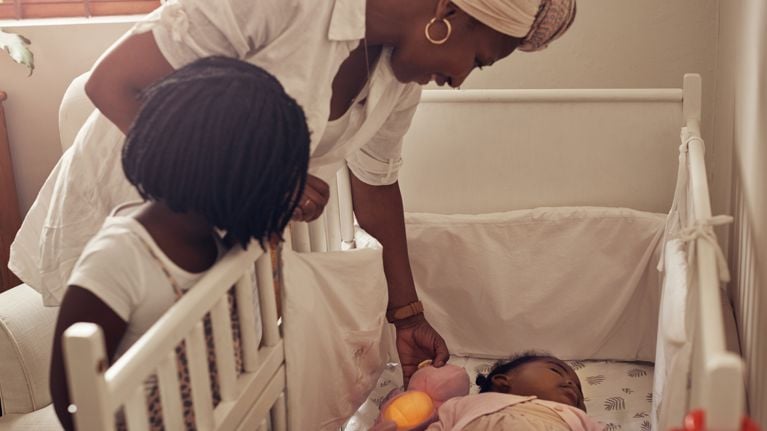
Extinction, or cry it out (CIO)
The idea behind extinction (or full extinction to differentiate it from graduated extinction) is that you want to extinguish the behaviour (crying) by not responding to it. As with the check-and-console method, go through your bedtime routine, put them in their crib awake, say good night and walk out. This is certainly the most controversial sleep-training method, and even experts disagree on what you should do next—it all depends on what stage your baby is at developmentally, as well as what works for the parents.
McGinn, for example, suggests leaving your baby until the morning, unless you’ve predetermined that they still need a feed in the night. “That first night can be rough,” says McGinn. “They could be up every hour crying.”
Mitelman, on the other hand, recommends that parents wait for at least one or two wake-ups before going back into the room. Then, if the baby wakes up after midnight, she believes it’s OK to go back in, comfort your baby for a few minutes and then leave again. She also supports scheduling in regular night-time feeds if your baby still needs them.
Parents are often hesitant to go this route, worried about how much crying will be involved. While McGinn doesn’t deny it can be difficult at first, she finds parents are often surprised by how quickly it works. “Yes, there is a lot of crying, but it’s short term,” she says. “You might get a lot of crying for two to three nights, but then every night is less and less.” She says you should see significant improvement with this method by night three or four but adds that it’s important to try it for a week before determining that it’s not working.

Chair method
This is a very gradual sleep-training method ( McGinn gives her clients a two-week plan for implementation) and requires a lot of discipline on the part of the parents. Again, you prep your baby for bed, but instead of leaving the room, you sit in a chair next to the crib. When they fall asleep, leave the room, but every time they wake up, sit back down in the chair until they fall back asleep. Every few nights, move the chair further and further away until you’re out of the room.
“The pro of this method is that mom or dad is there and present,” says McGinn. “But the con is, there will likely still be some crying, and now baby is watching you watch them cry. It can be really hard to be consistent with this method.”
Mitelman doesn’t recommend this method to her clients because she says having a parent in the room but not responding to the baby is confusing and may also be too much stimulation, depending on the baby’s age and developmental stage. “They can get so escalated to the point that they can’t calm themselves down,” she says.
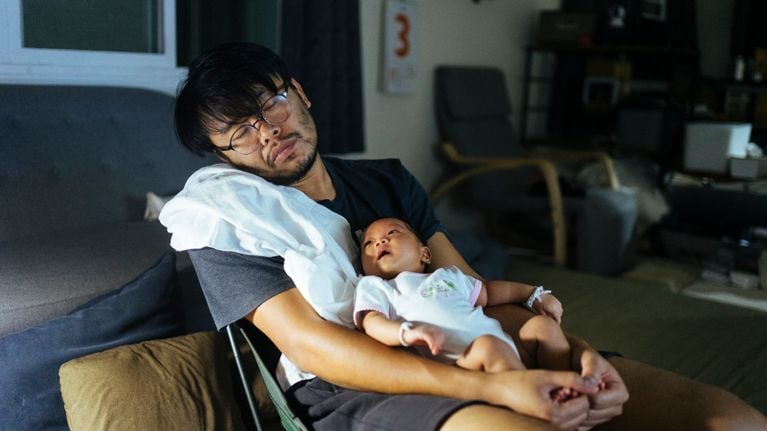
Pick up, put down and shush-pat
For babies younger than seven months, Garden prefers an approach where you stay in the room without giving them too much help to fall asleep. For example, you could stand over their crib and shush them, pat their tummy or apply pressure to calm and reassure them.
Another option is to let them fuss for a bit, but when they start to escalate, pick them up to soothe them but put them back down before they fall asleep. “Our job is to help calm the child, and their job is to fall asleep,” says Garden.
While these methods can work really well for younger babies, after six or seven months, your presence might make your baby more upset, and picking them up and putting them back down will likely be too much stimulation.
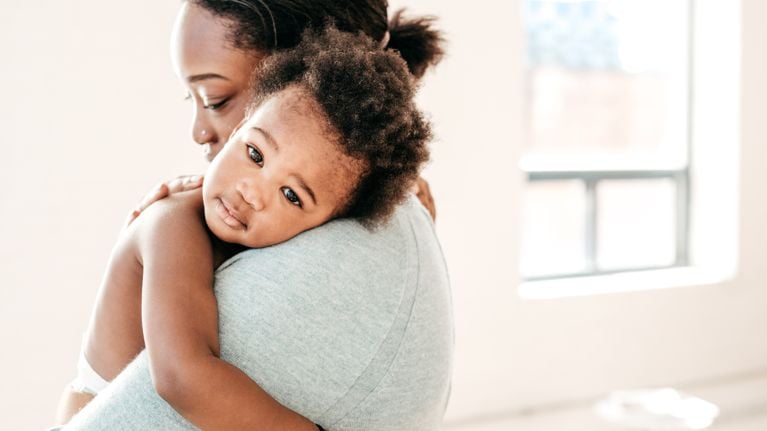
Bedtime-routine fading
With the fading technique, continue with whatever method you were using to help your baby fall asleep (such as rocking or nursing), but decrease the amount of time you spend doing it until, in theory, you don’t have to do it at all. This is a great technique for minimizing crying, but unfortunately, many parents find it difficult to sustain. “There has to be an end in sight,” explains Mitelman. “For example, we’ll meet this need for five to seven days and then we’ll pull back a little bit.” But if you’re willing to stick to the plan and get your baby to the end goal of going to bed without your assistance, Mitelman says it’s worth a try. “Whichever way the child can get to sleep independently is fine because that’s the key ingredient to sleeping through the night.”
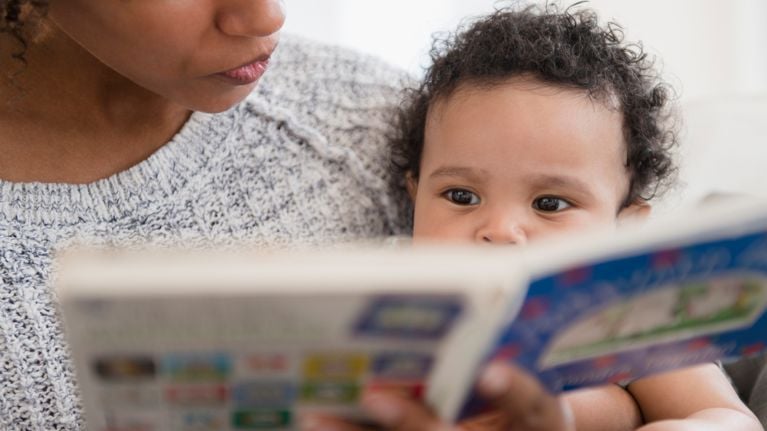
Bedtime-hour fading
Not to be confused with the bedtime-routine fading technique described above, bedtime-hour fading involves putting your baby into the crib at the time they usually end up dozing off, and making that their new bedtime for a couple of nights, and then gradually moving it to an earlier time. For example, say you always put your baby down at for the night at 7:30 p.m., but they tend to fuss or cry in the crib for 20 minutes or more, until they finally nod off around eight. This means 7:50 to 8 p.m. is actually their "natural bedtime," even though you'd like it to be earlier. To figure out when your baby naturally falls asleep, keep a diary for a few nights to track when they finally settle for the night. (Using a video monitor can help with this.) A few nights later, move the whole routine 15 minutes earlier. Continue moving the bedtime earlier by 15 minutes each night (if needed) until your baby has shifted their old habits to nod off at the desired time instead of the later one.
While McGinn doesn’t use this technique with her clients, she says the trick with any training routine is to be very consistent and commit to moving the bedtime earlier. “It’s easy to become inconsistent with things or give up and then the child has a really late bedtime,” says McGinn
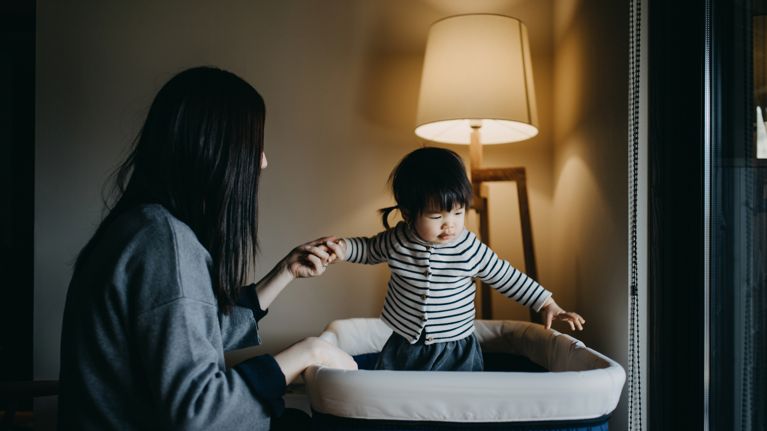
The greater good
On the advice of a sleep consultant, Welk and her husband took away Greyson’s pacifier, moved his bottle to before his bath (so he wouldn’t associate feeding with going to sleep) and chose to start with a very gentle method (because he was only four months old at the time). Greyson’s dad put him in the crib and stood next to him, patting him until he fell asleep, for about a week. That went well, and then they started leaving him immediately after putting him in the crib without patting him fully to sleep. “For about a month, he would cry or fuss every night for 10 to 15 minutes before falling asleep,” recalls Welk. It was hard to hear her baby cry, but she feels confident that it was for the greater good because they were both well rested and happy during the day. Now, Greyson is 11 months old and a champ sleeper, having weaned himself from night feeds at seven months.
If you’re on the fence about sleep training, it can be helpful to think of it this way: What is my baby’s developmental need right now? “At 11 months, they don’t need to eat during the night but they do need consistent sleep,” says Garden. Yes, those nights of crying are heartbreaking. But chances are, if you’re considering sleep training, it’s because what you’re currently doing isn’t working for you.
As your baby gets older and their sleep needs change, make sure that you’re adjusting wake times, naps and bedtimes accordingly to help them continue to easily fall asleep and stay asleep. Some parents think of sleep training as a “one-and-done” endeavour: You endure a lot of crying for a few days and your prize is a perfect sleeper. But it’s really a lifestyle change—once your child has the skills to fall asleep, they’ll still need routines, consistency and help adapting when life throws curveballs, like starting daycare, the arrival of a new sibling or going on a trip (where they may have to sleep in a different space or crib). Colds and illnesses, as well as time changes, can also throw a wrench in your perfect schedule. The trick here is to get back on track as soon as possible. If you start allowing or enabling the old, bad habits and sleep associations, it will take longer to return to the regular routine.
McGinn likens it to riding a bike: Sure, kids are a little wobbly when you get the bike out after the winter, but soon they’re riding like pros again. “You never have to re-teach the skill of falling asleep,” she says.
Do your research, talk to your doctor and if you're overwhelmed, consider hiring a sleep consultant or taking a workshop. Your baby’s sleep might seem like a mystery to you, but there are people who understand the complexities and can help. While not everyone agrees with every approach, no one would argue with the benefits of a good night’s sleep, for babies and exhausted parents alike.

Weekly Newsletter
Keep up with your baby's development, get the latest parenting content and receive special offers from our partners